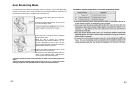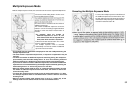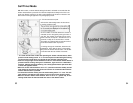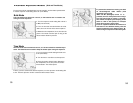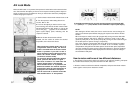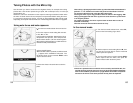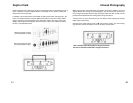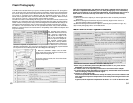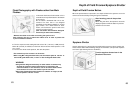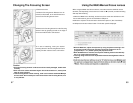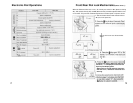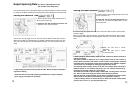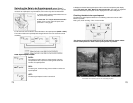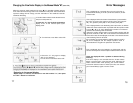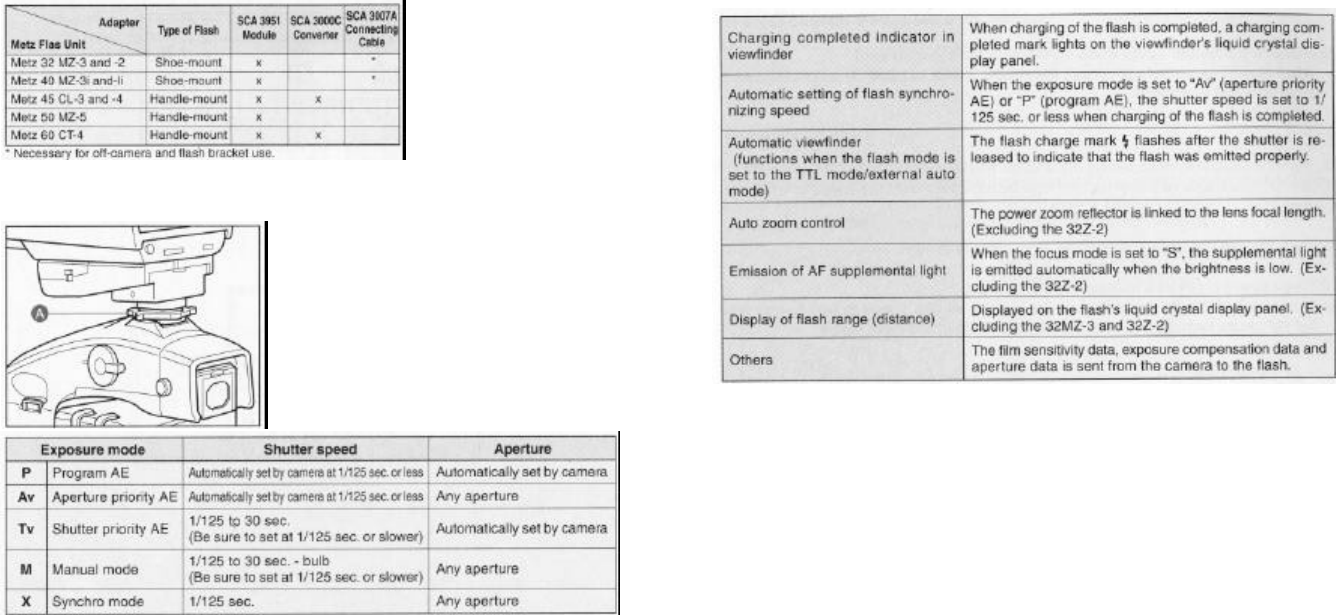
Flash Photography
In addition to its standard flash sync system, the Mamiya 645 AF features TTL (through the
lens), off the film (OTF), electronic flash exposure automation. A flash sensor located inside
the camera body reads the flash reflected off the film surface at the moment of exposure.
The sensor is connected via the Mamiya 645 AF's dedicated hot-shoe to a shoe- or
handle-mount style Metz flash unit via the Metz SCA 3951 TTL Adapter. Maximum flash
sync speed is 1/125 sec., making daytime syncronization possible.
The ISO of the flash is automatically set through the TTL connection from the camera's Film
Magazine; any adjustment to this is instantly recognized after the setting is locked and the
shutter release is half-pressed. Also, when Film Magazines with different ISO settings are
switched on the camera body, the TTL flash connection instantly recognizes the change.
To utilize the TTL flash feature with all TTL-operable Metz flash units, a Metz SCA 3951
Module is required. Please see chart below for compatibility and/or additional adapters that
may be necessary.
The resulting flash exposure
automation determines correct
flash exposure andautomati-
cally adjusts the output of the
flash. It also automatically cor-
rects for exposure compensa-
tion normally required when
using filters, close-up bellows
or extension tubes. However as
with all TTL systems, it requires manual compensation for differences in film surface
reflection characteristics. The amount of compensation is determined by experimentation
and is performed on the Mamiya 645 AF's Film Magazine ISO setting.
1. Mount the SCA3951 adapter onto the Metz
flash, insert fully into the camera's hot shoe, then
tighten with the fixing knob “A”
2. Set the exposure mode, then check the shutter
speed and aperture.
*With TTL flash photography, the reflection of the flash is metered and the intensity of
the flash is adjusted automatically, so TTL flash photography is not necessarily
suited to all conditions. In the cases described below, we recommend that you use a
flash meter to check the intensity of the flash or to use a manual flash setting.
For example:
(1) When the size of the subject you want to light with the flash is relatively small within
the picture
(2) When the background behind the subject is extremely bright or when there is a
strongly reflective object in the background
(3) When the background behind the subject is extremely dark (outdoors at night, etc.)
(4)
For flash photography with a narrow latitude film
Metz Flash SCA3951 System Functions
*The shutter cannot be released if the flash's OK lamp is lit.
*When using an SCA300 system flash (Metz 60CT-4,45CL-4, etc.), also use the
SCA3000C converter (sold separately).
*For details, refer to the operating instructions of the flash and the adapter.
*To use the guide number indicated on the flash fully, emit the flash several seconds
after the charging completed indicator lights.
*Cautions on using instant film
Instant film (Polaroid 100-600 series and Fuji FP series), has a lower reflection rate
than regular film. Exposure compensation is necessary when using the flash in the
TTL mode.
In general, set the exposure compensation to about 1 or 1 1/3 EV on the minus side.
63
64




